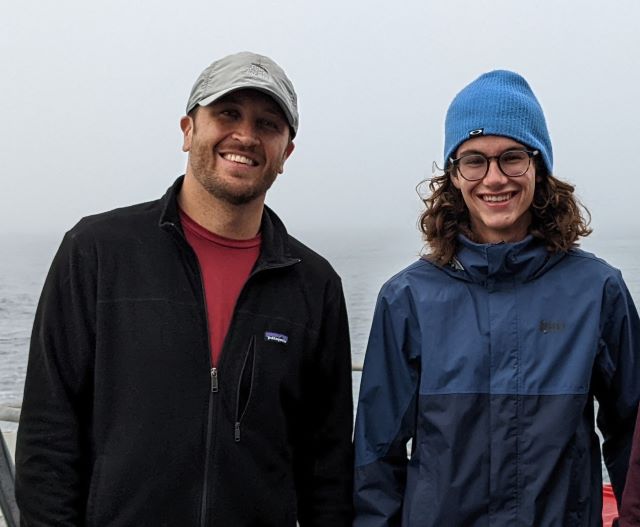Cal Poly study analyzes marine heat waves, cold spells

Ryan Walter, from left, a Cal Poly associate professor of physics with specialization in oceanography, and Michael Dalsin, a Cal Poly physics senior from Minnesota, are collaborating on research to better understand how climate change is impacting extreme ocean temperatures off California’s Central Coast. Their article published in the journal Nature Scientific Reports analyzes California ocean temperature data spanning four decades.
Article published in the journal Nature Scientific Reports analyzes California ocean temperature data spanning four decades
– Cal Poly student and faculty researchers, in conjunction with a team on the East Coast, are exploring how climate change is impacting extreme ocean temperatures off California’s Central Coast.
Together with the Virginia Institute of Marine Science in Gloucester Point, the graduate school in marine science for the College of William & Mary, the first-ever study looks at drivers of both marine heat waves and cold spells in the shallow waters along the California coast. The work is investigating conditions that lead to extreme water temperatures. Spikes in warm waters, known as marine heat waves, can be exacerbated by rising global temperatures. On the opposite extreme are prolonged periods of cold waters, known as marine cold spells. In California, varying upwelling patterns significantly influence these coastal water temperature extremes.
The findings were published July 31, in a Nature Scientific Reports article titled “Effects of basin-scale climate modes and upwelling on nearshore marine heatwaves and cold spells in the California Current.” This research provides a better understanding of when, where, and why these extreme marine events occur.
“One thing is clear,” said Ryan Walter, a coauthor and Cal Poly associate professor of physics specializing in physical oceanography. “These extreme temperature events are not going away, so it is critical that we continue to explore their drivers and consequences.”
Atmospheric heat waves are causing millions to suffer. Climatologists’ expectation is that 2023 will be the hottest year on record.
Human-caused climate change has also led to extreme ocean temperatures — a water sensor 5-feet underwater at Manatee Bay, Florida, reached 101.1 degrees Fahrenheit on July 24, eclipsing the previous sea surface record of 99.7 degrees in Kuwait Bay, set in 2020, according to Cal Poly. These temperature extremes cause detrimental impacts on marine ecosystems and ocean-related ecology.
It has long been known that coastal upwelling — the wind-driven transport of deep, cold water into shallow areas along the coast — has a strong cooling effect on coastal waters, creating foggy marine layers and stimulating marine productivity. Upwelling helps maintain healthy fisheries and robust marine life. The cold waters also help buffer against rising water temperatures frequently found farther from shore and in other locations around the world like Florida, which does not experience the strong upwelling found in California.
“Upwelling systems in general are among the world’s most productive ecosystems, including many of the world’s fisheries and beautiful kelp forests,” Walter said. “Because the deep upwelled waters are cold, they help mitigate some of the warm water extremes. Additionally, these deep, cold waters are full of nutrients — and when they upwell, they effectively fertilize the surface of the ocean and lead to strong biological productivity.”
Cal Poly undergraduate physics senior Michael Dalsin served as the lead author along with co-authors Walter and Piero Mazzini, an assistant professor at the Virginia Institute of Marine Science.
“This study lays the foundation for understanding how temperature extremes in our ocean will respond to climate change,” said Dalsin, an undergraduate who has won multiple awards for his work on the study, including an American Meteorological Society (AMS) Student Award for his oral presentation at the organization’s 2023 annual meeting. The Edina, Minnesota, resident was also one of 10 students selected to represent Cal Poly at the 2023 California State University Student Research Competition where he presented findings of the recently published article.
When ocean temperatures along the California coast warm during El Niño years, such as the one forecasted to take place this winter, marine ecosystems can be severely impacted if the temperatures get too hot. In the past, these marine heatwaves have led to giant kelp forest loss, mass die-offs of seabirds and economically important fisheries, and harmful algal blooms.
During normal conditions, trade winds, which blow from east to west along the equator of the Pacific Ocean, push warm surface waters towards Asia, piling them up in the western Pacific. This year, the trade winds are expected to weaken or even reverse. This will cause the warm surface water to move east, leading to warmer than normal waters in the equatorial Pacific, also known as “El Niño” conditions. This can also cause warmer than normal waters along the California coast and reduced upwelling of cold water. Its climate impacts show up mostly in the winter months over North America.
The study found that certain environmental conditions and the state of the ocean (El Niño and La Niña years, for example) led to an enhanced risk for marine heat waves and cold spells, conditions that scientists and environmental managers will need to monitor to preserve and protect vital ecosystems critical to the California ocean or Blue Economy. The researchers also investigated the Pacific Decadal Oscillation (PDO), a large-scale pattern of temperature in the North Pacific that varies over time scales of years.
“There is high confidence that, because of climate change, El Niño events will increase in frequency and intensity,” Walter said. “And so, if we have stronger El Niño events in the future, we expect to see more frequent and more extreme marine heat waves and all the consequences that come with it.”
During the last major El Niño in 2015-16, a long-duration marine heat wave contributed to the collapse of the species-rich kelp forests in parts of California.
The team analyzed ocean temperatures, from 1978-2020, taken in a fixed Central Coast location near the Diablo Canyon nuclear power plant. This kind of ocean data going back more than four decades is somewhat rare, but long-term datasets are needed to calculate heat waves and cold spells. The data used is unique to the Central Coast and exists because of the power plant.
Along with variable ocean and weather conditions caused during El Niño and La Niña years, as well as changes in the PDO, the study found short-term upwelling patterns also can trigger the temperature spikes that can cause temporary and permanent damage to marine ecosystems. Thermal stress, both hot and cold, can significantly affect aquaculture and fisheries, both important components of the Blue Economy. In the future, it will be increasingly important to understand how wind patterns and surface warming from climate change affect upwelling along California’s coast, according to Walter.
The article went on to explain how California coastal marine environments generally aren’t warming as much as other parts of the world. “If we didn’t have upwelling along our coast, we’d see far more heat waves,” Walter said. “So, the upwelling is cooling down nearshore regions along the coast and causes the climate-induced warming signal to be more muted. This also provides a thermal refuge for marine organisms.”
Dalsin added: “One fascinating aspect of our research is that we can predict the likelihood of one of these extreme marine events given the state of our ocean. The state of the ocean, as determined by large-scale climate modes and local-scale upwelling winds, could be used to forecast heat waves and cold spells in the future.”
The research was supported by the William and Linda Frost Fund in the Cal Poly Bailey College of Science and Mathematics.





















